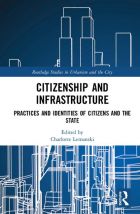Citizenship and Infrastructure: Practices and Identities of Citizens and the State

Citizenship and Infrastructure introduces and deploys the concept of “infrastructural citizenship” as a lens through which to understand the everyday practices and identities of citizens, and how these affect and are affected by everyday access to public urban infrastructure. The book represents an attempt to connect the strands of contemporary urban literature on infrastructure and citizenship. It argues that although infrastructure, citizenship and urbanization are inherently interrelated concepts, their connections are under-theorized and largely left implicit within urban, political and development scholarship. Although infrastructure is often reduced to its techno-material dimension, it is both conditioned by and a contributor to socio-political life. Therefore, the concept of infrastructural citizenship calls attention to the connections between the material and political nature of state-society relations.
Part of the Routledge Studies in Urbanism and the City series, the volume comprises six chapters drawing from a range of examples in various urban African and Asian contexts. These examples demonstrate the inherent relationship between citizenship and infrastructure and the merits of acknowledging and theorizing this relationship for urban theory and practice.
The volume’s editor, Charlotte Lemanski, contributes the first example: a case study of state-subsidized housing in Cape Town (Chapter 1). The South African context is particularly interesting because of the historic impact of apartheid on citizenship and infrastructure. During the apartheid era, non-white races were denied citizenship and therefore the right to own property, vote, or move freely in South Africa’s cities. In the post-apartheid period, all South Africans were granted full citizenship rights; however, “access to services is still skewed according to income and spatial location, and thus access to infrastructure continues to play a major role in mediating perceptions and practices of citizenship” (page 17). Since 1994, the post-apartheid state has constructed over 3 million state-subsidized houses and distributed ownership of these to low-income households. These houses represent a physical manifestation of housing beneficiaries’ newly granted citizenship. Yet, for some beneficiaries, the low quality of construction, small size of houses and location of the settlements also represent the perpetuation of inequality and marginalization, particularly in relation to the material wealth of other citizens. Thus, this chapter demonstrates how citizenship's practices, perceptions and expressions are embedded in the physicality of public infrastructure (in this case, housing) as a representation of the state at a local scale.
Book note prepared by Kate Goh
Search the Book notes database
Our Book notes database contains details and summaries of all the publications included in Book notes since 1993 - with details on how to obtain/download.
Use the search form above, or visit the Book notes landing page for more options and latest content.
For a searchable database for papers in Environment and Urbanization, go to http://eau.sagepub.com/

